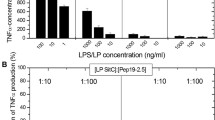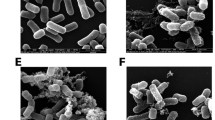Abstract
Endotoxin, also identified as lipopolysaccharide (LPS), is considered the pathogenic factor of septic shock triggered by Gram-negative bacteria and generates inflammatory responses. Synthetic peptides have attracted increasing attention from researchers for the blocking of LPS and treatment of sepsis. The aim of the study was to design a novel synthetic anti-endotoxin peptide and evaluate its effect in vitro. To design a new peptide, anti-endotoxin peptides were extracted from the APD3 site. The physicochemical features, secondary structure content, and tertiary structure type of each residue were determined by ProtParam, GOR IV, pep-fold, and I-TASSER. Hemolytic activity and cytotoxicity of the peptide on RAW264.7 cells were assessed by human RBC hemolysis test and MTT assay, respectively. Real-time PCR and western blot were used to evaluate the gene expression of IL-1β, TNF-α, IL-6, IL-10, iNOS, and TLR4, as well as the protein expression of NF-KB(P65), correspondingly. The designed peptide has 13 amino acid residues (GRRWWRFKKWWKF). The second structure of the peptide had 46.15% random coil and 53.85% extended strand. The results of the prediction of the tertiary structure demonstrated the peptide forms an alpha helix structure. It possesses low hemolytic activity and low cytotoxicity against RAW264.7 cells. This peptide remarkably restored LPS-induced TLR4 overexpression, and reduced gene expression of IL-1β, IL-6, iNOS, and TNF-α, whereas increased IL-10. This peptide significantly reduced the protein expression of NF-KB (P65). These findings imply that this peptide with low toxicity, hemolytic activity, and LPS-neutralizing activity merits more research as a possible anti-LPS agent for managing septic shock.









Similar content being viewed by others
Data Availability
All data generated or analyzed during this study are included in this published article.
References
Ahmad B, Hanif Q, Xubiao W, Lulu Z, Shahid M, Dayong S, Rijun Z (2019) Expression and purification of hybrid LL-37Tα1 peptide in pichia pastoris and evaluation of its immunomodulatory and anti-inflammatory activities by LPS neutralization. Front Immunol 10:1365
Ajish C, Yang S, Kumar SD, Lee CW, Kim DM, Cho SJ, Shin SY (2023) Cell selectivity and antibiofilm and anti-inflammatory activities and antibacterial mechanism of symmetric-end antimicrobial peptide centered on D-Pro-Pro. Biochem Biophys Res Commun 666:21–28
Bauer M, Gerlach H, Vogelmann T, Preissing F, Stiefel J, Adam D (2020) Mortality in sepsis and septic shock in Europe, North America and Australia between 2009 and 2019—results from a systematic review and meta-analysis. Crit Care 24:1–9
Brandenburg K et al (2021) An update on endotoxin neutralization strategies in Gram-negative bacterial infections. Expert Rev Anti-Infect Ther 19:495–517
Cecconi M, Evans L, Levy M, Rhodes A (2018) Sepsis and septic shock. Lancet 392:75–87
Chei S, Oh HJ, Lee K, Jin H, Lee JY, Lee BY (2020) Dietary silk peptide inhibits LPS-induced inflammatory responses by modulating toll-like receptor 4 (TLR4) signaling. Biomolecules 10:771
Curren EJ et al (2022) Advancing diagnostic stewardship for healthcare-associated infections, antibiotic resistance, and sepsis. Clin Infect Dis 74:723–728
Deo S, Turton KL, Kainth T, Kumar A, Wieden HJ (2022) Strategies for improving antimicrobial peptide production. Biotechnol Adv 59:107968
Duan GJ, Zhu J, Wan JY, Li X, Ge XD, Liu LM, Liu YS (2010) A synthetic MD-2 mimetic peptide attenuates lipopolysaccharide-induced inflammatory responses in vivo and in vitro. Int Immunopharmacol 10:1091–1100
Gabarin RS, Li M, Zimmel PA, Marshall JC, Li Y, Zhang H (2021) Intracellular and extracellular lipopolysaccharide signaling in sepsis: avenues for novel therapeutic strategies. J Innate Immun 13:323–332
Garnier J, Gibrat JF, Robson B (1996) GOR method for predicting protein secondary structure from amino acid sequence. Methods in enzymology, vol 266. Elsevier, Amsterdam, pp 540–553
Gasteiger E, Hoogland C, Gattiker A, Se D, Wilkins MR, Appel RD, Bairoch A (2005) Protein identification and analysis tools on the ExPASy server. Springer, New York
Greco I et al (2020) Correlation between hemolytic activity, cytotoxicity and systemic in vivo toxicity of synthetic antimicrobial peptides. Sci Rep 10:13206
Guo C, Li J, Lee W, Li H, Shen J, Zhang B (2021) A novel peptide identified from skin secretions of Bombina maxima possesses LPS-neutralizing activity. Biochem Biophys Res Commun 550:107–112
Hu Z, Murakami T, Suzuki K, Tamura H, Kuwahara-Arai K, Iba T, Nagaoka I (2014) Antimicrobial cathelicidin peptide LL-37 inhibits the LPS/ATP-induced pyroptosis of macrophages by dual mechanism. PLoS ONE 9:e85765
Hu Z et al (2016) Antimicrobial cathelicidin peptide LL-37 inhibits the pyroptosis of macrophages and improves the survival of polybacterial septic mice. Int Immunol 28:245–253
Jacob B, Park IS, Bang JK, Shin SY (2013) Short KR-12 analogs designed from human cathelicidin LL-37 possessing both antimicrobial and antiendotoxic activities without mammalian cell toxicity. J Peptide Sci 19:700–707
Kim HS, Lee JH, Moon SH, Ahn DU, Paik HD (2020) Ovalbumin hydrolysates inhibit nitric oxide production in LPS-induced RAW 2647 macrophages. Food Sci Animal Resour 40:274
Lamiable A, Thévenet P, Rey J, Vavrusa M, Derreumaux P, Tufféry P (2016) PEP-FOLD3: faster de novo structure prediction for linear peptides in solution and in complex. Nucleic Acids Res 44:W449–W454
Lee JK, Seo CH, Luchian T, Park Y (2016) Antimicrobial peptide CMA3 derived from the CA-MA hybrid peptide: antibacterial and anti-inflammatory activities with low cytotoxicity and mechanism of action in Escherichia coli. Antimicrob Agents Chemother 60:495–506
Lesiuk M, Paduszyńska M, Greber KE (2022) Synthetic antimicrobial immunomodulatory peptides: ongoing studies and clinical trials. Antibiotics 11:1062
Li Z, Qu W, Zhang D, Sun Y, Shang D (2023) The antimicrobial peptide chensinin-1b alleviates the inflammatory response by targeting the TLR4/NF-κB signaling pathway and inhibits Pseudomonas aeruginosa infection and LPS-mediated sepsis. Biomed Pharmacother 165:115227
Lyu Y et al (2023) Broad-spectrum hybrid antimicrobial peptides derived from PMAP-23 with potential LPS binding ability. Biochem Pharmacol 210:115500
Madanchi H, Ebrahimi Kiasari R, Seyed Mousavi SJ, Johari B, Shabani AA, Sardari S (2020) Design and synthesis of lipopolysaccharide-binding antimicrobial peptides based on truncated rabbit and human CAP18 peptides and evaluation of their action mechanism. Probiot Antimicrob Prot 12:1582–1593
Malan M, Serem JC, Bester MJ, Neitz AW, Gaspar AR (2016) Anti-inflammatory and anti-endotoxin properties of peptides derived from the carboxy-terminal region of a defensin from the tick Ornithodoros savignyi. J Pept Sci 22:43–51
Martinez R, Aguirre DS, Warne C, Dick G, Mallet R, Tune J, Hodge L (2022) Cytokine response in an endotoxin-mediated sepsis model
Nežić L et al (2022) Amelioration of endotoxin-induced acute lung injury and alveolar epithelial cells apoptosis by simvastatin is associated with up-regulation of survivin/NF-KB/p65 pathway. Int J Mol Sci 23:2596
Pant A, Mackraj I, Govender T (2021) Advances in sepsis diagnosis and management: a paradigm shift towards nanotechnology. J Biomed Sci 28:1–30
Pérez-Hernández EG, Delgado-Coello B, Luna-Reyes I, Mas-Oliva J (2021) New insights into lipopolysaccharide inactivation mechanisms in sepsis. Biomed Pharmacother 141:111890
Pfalzgraff A, Heinbockel L, Su Q, Brandenburg K, Weindl G (2017) Synthetic anti-endotoxin peptides inhibit cytoplasmic LPS-mediated responses. Biochem Pharmacol 140:64–72
Rahman MS, Alam MB, Kim YK, Madina MH, Fliss I, Lee SH, Yoo JC (2021) Activation of nrf2/ho-1 by peptide yd1 attenuates inflammatory symptoms through suppression of tlr4/myyd88/nf-κb signaling cascade. Int J Mol Sci 22:5161
Rudd KE et al (2020) Global, regional, and national sepsis incidence and mortality, 1990–2017: analysis for the global burden of disease study. Lancet 395:200–211
Ryu JK et al (2017) Reconstruction of LPS transfer cascade reveals structural determinants within LBP, CD14, and TLR4-MD2 for efficient LPS recognition and transfer. Immunity 46:38–50
Sánchez-Hernández JP, Frausto-Solís J, Soto-Monterrubio DA, González-Barbosa JJ, Roman-Rangel E (2022) A peptides prediction methodology with fragments and CNN for tertiary structure based on GRSA2. Axioms 11:729
Shang D, Zhang Q, Dong W, Liang H, Bi X (2016) The effects of LPS on the activity of Trp-containing antimicrobial peptides against gram-negative bacteria and endotoxin neutralization. Acta Biomater 33:153–165
Śmiechowicz J (2022) The rationale and current status of endotoxin adsorption in the treatment of septic shock. J Clin Med 11:619
Soleimanifar H, Hosseini HM, Tehrani SS, Mirhosseini SA (2023) The anti-adhesion effect of nisin as a robust lantibiotic on the colorectal cancer cells. Adv Biomed Res 12:113
Sun Y, Shang D (2015) Inhibitory effects of antimicrobial peptides on lipopolysaccharide-induced inflammation. Mediators Inflamm. https://doi.org/10.1155/2015/167572,2015
Tehrani SS, Goodarzi G, Panahi G, Zamani-Garmsiri F, Meshkani R (2023) The combination of metformin with morin alleviates hepatic steatosis via modulating hepatic lipid metabolism, hepatic inflammation, brown adipose tissue thermogenesis, and white adipose tissue browning in high-fat diet-fed mice. Life Sci 323:121706
Tian M et al (2023) The first Brevinin-1 antimicrobial peptide with LPS-neutralizing and anti-inflammatory activities in vitro and in vivo. Front Microbiol 14:1102576
Torres MD, Sothiselvam S, Lu TK, de la Fuente-Nunez C (2019) Peptide design principles for antimicrobial applications. J Mol Biol 431:3547–3567
Wang Z, Jiang W, Zhang Z, Qian M, Du B (2012) Nitidine chloride inhibits LPS-induced inflammatory cytokines production via MAPK and NF-kappaB pathway in RAW 264.7 cells. J Ethnopharmacol 144:145–150
Wang Q, Jin L, Wang H, Tai S, Liu H, Zhang D (2018) Awrk6, a synthetic cationic peptide derived from antimicrobial peptide dybowskin-2cdya, inhibits lipopolysaccharide-induced inflammatory response. Int J Mol Sci 19:600
Wang G, Zietz CM, Mudgapalli A, Wang S, Wang Z (2022) The evolution of the antimicrobial peptide database over 18 years: milestones and new features. Protein Sci 31:92–106
Xuan J et al (2023) Antimicrobial peptides for combating drug-resistant bacterial infections. Drug Resist Updates 68:100954
Zhang YY, Ning BT (2021) Signaling pathways and intervention therapies in sepsis. Signal Transd Target Ther 6:407
Acknowledgements
The authors wish to express their sincere gratitude to the Applied Microbiology Research Center, Systems Biology and Poisonings Institute for approving the proposal of this study and its implementation (Grant number: 400000474).
Author information
Authors and Affiliations
Contributions
SST: wrote the main manuscript text, HMH: prepared figures, SAM: reviewed the manuscript.
Corresponding author
Ethics declarations
Competing interests
The authors have nothing to declare.
Additional information
Publisher's Note
Springer Nature remains neutral with regard to jurisdictional claims in published maps and institutional affiliations.
Rights and permissions
Springer Nature or its licensor (e.g. a society or other partner) holds exclusive rights to this article under a publishing agreement with the author(s) or other rightsholder(s); author self-archiving of the accepted manuscript version of this article is solely governed by the terms of such publishing agreement and applicable law.
About this article
Cite this article
Tehrani, S.S., Hosseini, H.M. & Mirhosseini, S.A. Evaluation of Anti-endotoxin Activity, Hemolytic Activity, and Cytotoxicity of a Novel Designed Peptide: An In Silico and In Vitro Study. Int J Pept Res Ther 30, 16 (2024). https://doi.org/10.1007/s10989-024-10591-0
Accepted:
Published:
DOI: https://doi.org/10.1007/s10989-024-10591-0




